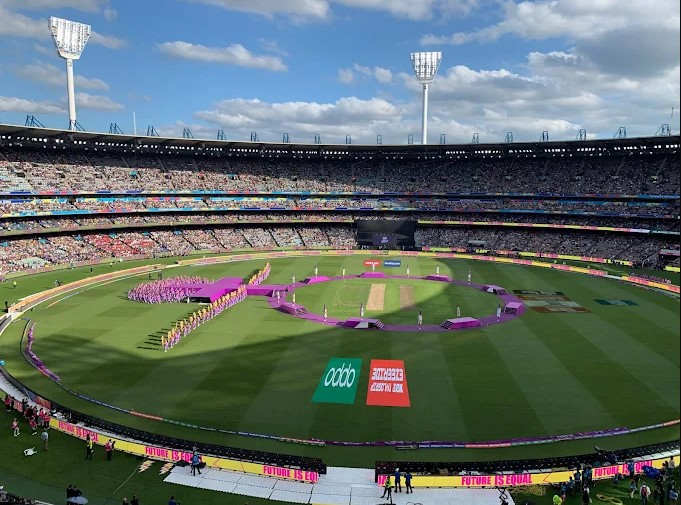The Melbourne Cricket Ground (MCG) is more than just a stadium — it is a cultural icon. Located in Yarra Park, Melbourne, and built in 1853, the MCG is the largest stadium in the Southern Hemisphere and a central hub for both cricket and Australian Rules Football (AFL). Hosting countless historic events — from Olympic Games to Boxing Day Tests and AFL Grand Finals — the MCG is synonymous with Australian sport.
Table of Contents
One crucial, often overlooked feature of the MCG is its boundary length. This metric, central to both cricket and AFL, affects how games are played, the strategies employed by athletes, and the overall spectacle for fans.
Understanding Boundary Length
Boundary length refers to the measurable edge of the playing area — the line or fence that encloses the playing surface.
- In cricket, it defines the distance from the pitch to the fence or rope. The longer the boundary, the harder it is for batters to score fours and sixes.
- In AFL, boundary length refers to the elliptical perimeter of the field. It influences running patterns, stamina demands, and game dynamics.
MCG Boundary Dimensions: An Overview
The MCG is renowned for its large and near-symmetrical ground. While the exact length can vary depending on how the pitch is centered and how the field is marked for different sports, standard measurements are consistent across international games.
1. Cricket Configuration
| Boundary Area | Distance (in meters) |
|---|---|
| Straight (long on/off) | 80 – 85 |
| Square of wicket | 86 – 90 |
| Behind square | 80 – 85 |
Total boundary length (cricket rope): ~560–600 meters (approximate circumference)
2. AFL Configuration
| Dimension | Measurement (in meters) |
|---|---|
| Length (goal to goal) | 160 |
| Width (wing to wing) | 141 |
| Perimeter (Boundary) | ~483 meters |
Using the elliptical perimeter formula: P≈π×2(a2+b2)P \approx \pi \times \sqrt{2(a^2 + b^2)}
Where:
- a = semi-major axis = 80 m
- b = semi-minor axis = 70.5 m
This gives an approximate perimeter of ~483 meters, making it one of the longest-running grounds in the AFL.
Historical Context and Evolution
The MCG has undergone many renovations since the 19th century. The boundary length has remained relatively stable, but adjustments in seating arrangements and safety zones have shifted the playable area slightly over the decades.
| Year | Major Change | Impact on Boundary |
|---|---|---|
| 1956 | Olympic Games Renovation | Increased space and amenities |
| 1992 | Great Southern Stand built | Reduced sideline clearance |
| 2006 | Northern Stand upgrade | More compact crowd-to-boundary design |
| 2013+ | Laser measuring for boundary rope | Greater accuracy in cricket dimensions |
Cricket Implications
1. Favoring Bowlers
Large boundaries mean that even well-struck shots may fall short of the rope, especially square of the wicket. This favors bowlers, especially spinners and fast bowlers who can use the size to challenge big hitters.
2. Running Between Wickets
Batsmen often rely more on running twos and threes, testing endurance and teamwork. Singles are often turned into doubles due to the large gaps between fielders.
3. Spectator Dynamics
The large boundary allows fielders more room to chase the ball and make spectacular saves near the rope — enhancing the viewing experience both live and on broadcast.
AFL Implications
1. Wide, Open Play
The oval size facilitates open, expansive play. Teams with elite runners and quick ball movement thrive at the MCG.
2. Tactical Kicking and Spacing
More space encourages strategic kicking patterns, especially switches across the ground and defensive rebounds that transition into attacking plays.
3. Fitness Factor
Comparison with Other Major Stadiums
Cricket Ground Boundary Lengths
| Stadium | Straight (m) | Square (m) | Perimeter (approx. m) |
|---|---|---|---|
| MCG | 80 – 85 | 86 – 90 | ~580 |
| SCG (Sydney) | 60 – 65 | 55 – 60 | ~480 |
| Optus Stadium (Perth) | 75 – 80 | 65 – 70 | ~550 |
| Eden Gardens (India) | 66 – 70 | 63 – 68 | ~510 |
| Lord’s (England) | 65 – 70 | 60 – 65 | ~500 |
AFL Oval Sizes
| Stadium | Length (m) | Width (m) | Perimeter (approx. m) |
|---|---|---|---|
| MCG | 160 | 141 | ~483 |
| Adelaide Oval | 167 | 124 | ~470 |
| Optus Stadium | 165 | 130 | ~475 |
| SCG | 155 | 136 | ~465 |
Technology and Boundary Marking
Today, the MCG uses laser surveying and digital mapping to mark precise boundary lines. In cricket, the rope is typically laid 3 meters inside the fence to ensure player safety. Ground staff coordinate closely with match officials to ensure dimensions comply with ICC and AFL regulations.
Challenges and Criticisms
Some visiting cricket teams, particularly from the subcontinent, have voiced concerns about the large boundaries impacting batting statistics. Likewise, in AFL, clubs accustomed to smaller ovals (like Geelong’s GMHBA Stadium) often find the MCG demanding.
Future Outlook
With emerging sports like Big Bash League and proposals for hybrid international events, there may be future innovations like adjustable boundary systems or augmented reality overlays that digitally resize fields. The MCG is well positioned to lead in these developments due to its technology infrastructure.
The boundary length of the MCG is one of its defining features. Whether it’s a Test match on Boxing Day or an AFL Grand Final, the stadium’s scale affects strategy, performance, and spectator experience. With straight boundaries ranging up to 85 meters, square boundaries over 90 meters, and an AFL perimeter of about 483 meters, the MCG remains one of the grandest stages in world sport — demanding nothing less than excellence.


